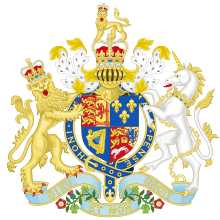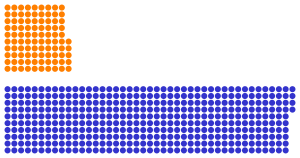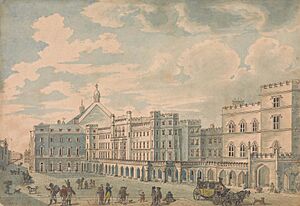Parliament of Great Britain facts for kids
Quick facts for kids Parliament of the Kingdom of Great Britain |
|
|---|---|

Royal coat of arms of Great Britain, 1714–1800
|
|
| Type | |
| Type | |
| Houses | House of Lords House of Commons |
| History | |
| Established | 1 May 1707 |
| Disbanded | 31 December 1800 |
| Preceded by | Parliament of England< |
| Succeeded by | Parliament of the United Kingdom of Great Britain and Ireland |
| Leadership | |
|
Lord Loughborough
Since 1793 |
|
|
Henry Addington
Since 1789 |
|
 |
|
|
House of Commons political groups
|
Final composition of the British House of Commons: 519 Seats Tories: 424 seats Whigs: 95 seats |
| Elections | |
| Ennoblement by the Sovereign or inheritance of a peerage | |
| First-past-the-post with limited suffrage | |
| Meeting place | |
 |
|
| Palace of Westminster, London | |
| Footnotes | |
| See also: Parliament of Ireland |
|
The Parliament of Great Britain was a very important group of lawmakers. It was created in May 1707. This happened after the Acts of Union were agreed upon by both the Parliament of England and the Parliament of Scotland.
These Acts created a new country called the Kingdom of Great Britain. The new Parliament met in the Palace of Westminster in London. This was the same place where the English Parliament used to meet. The Parliament of Great Britain lasted for almost 100 years. It ended on December 31, 1800. Then, it joined with the Irish Parliament to form the Parliament of the United Kingdom.
Contents
How the Parliament Started
After the Treaty of Union in 1706, the Acts of Union were passed. Both the English and Scottish Parliaments agreed to them. This led to the creation of the new Kingdom of Great Britain.
The Acts also created the new Parliament of Great Britain. It used the same rules and traditions as the old English Parliament. Most of the members and leaders were from England. There was no new election when it started.
Scottish laws remained separate in many ways. However, new laws for the whole country were made by this new Parliament. England had a very strong influence in the new Parliament. This was a topic of debate for a long time.
Changes in Power
When King George I became king in 1714, power started to shift. He was from Germany and didn't speak English well. He was more interested in his lands in Europe. So, he gave more power to his ministers.
One of the most important ministers was Sir Robert Walpole. By the time George I's rule ended in 1727, the ministers had a lot of power. They needed the Parliament's support to get things done.
His son, George II, continued this way of ruling. He didn't try to take back control from Parliament. By the late 1700s, the king still had some influence. But he no longer had direct power over laws. For example, the last time a king or queen refused a law was in 1708.
Who Could Vote?
Voting in elections was very limited. Only landowners and people who owned property could vote. Many voting areas, called "rotten boroughs," were very old. They didn't represent where people actually lived. In these areas, rich landowners could often buy seats in Parliament. Big cities often had no representation at all.
People who wanted change, called "reformers," pushed for changes to the voting system. But when the French Revolutionary Wars started, the government became stricter. This stopped progress on reforms for a while.

King George III's Reign
King George III tried to bring back more royal power. But by the end of his reign, his ministers were in charge. They learned that they needed Parliament's support for any big changes. This made Parliament very central to how Britain was governed.
During the first half of George III's rule, the king still had a lot of influence. Parliament was mostly controlled by rich English families. Most people running for Parliament were called Whigs or Tories. But once elected, they often worked together in different groups.
The voting system was still unfair. Seats in Parliament could be bought in "rotten boroughs." Major cities still had no voice. Reformers like John Wilkes wanted to fix this system. In 1780, some ideas for reform were suggested. These included points that later became part of the Chartist movement.
American War of Independence
The American War of Independence ended badly for Britain. The thirteen American colonies broke away and formed their own country, the United States. King George III had strongly wanted to prevent this.
In 1782, the king had to appoint a government led by his opponents. They wanted to reduce the king's power. In 1783, the king used his influence in the House of Lords to stop a bill. He then fired the government and appointed William Pitt the Younger. Pitt had wanted Parliament to reform itself. But he didn't push for reforms the king disliked. His ideas to move seats from "rotten boroughs" to cities were rejected in 1785.
After the French Revolution in 1789, groups like the London Corresponding Society formed. They pushed for changes to Parliament. But as the French Revolutionary Wars continued, the government took strong actions against these groups. They feared unrest like in France. This stopped progress on reforms for many years.
Joining with Ireland
In 1801, the Parliament of Great Britain joined with the Parliament of Ireland. This created the United Kingdom of Great Britain and Ireland. The new Parliament was called the Parliament of the United Kingdom. This change happened because of the Acts of Union 1800.
How Members Were Chosen
The Parliament of Great Britain had two parts: the House of Lords and the House of Commons.
- The House of Lords was made up of nobles. They either inherited their titles or were given them by the King or Queen.
- The House of Commons had members elected by the people. However, only certain men who owned property could vote. This was called "limited suffrage."
Most members of Parliament came from England. Scotland and Wales also sent members, but fewer. For example, England had 486 members, while Scotland had 45 and Wales had 27. This meant that each member in England represented fewer people than in Scotland or Wales.
See also
 In Spanish: Parlamento del Reino Unido para niños
In Spanish: Parlamento del Reino Unido para niños

